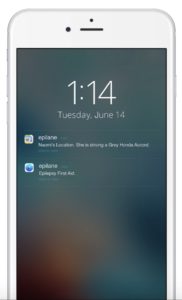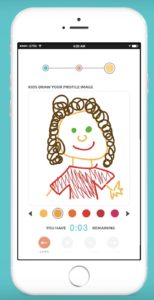
Epilane alerts drivers with epilepsy and their emergency contacts if the driver exhibits symptoms of seizures. The app would integrate an IoT steering wheel to monitor pulse and abnormal movements in the hands. Courtesy Yajayra Barragan.
What’s next in dating and health care smartphone apps, and how does one design for certain demographics or disabilities?
Communication design majors and recent graduates at Texas State University took on this unique challenge in their project, HEXDesign, which will be presented during the TXST Innovation Lab at SXSW.
HEXDesign is a collective of eight app prototypes; four tackle digital dating while the other four cover emerging health care topics and ways to monitor, interact and alert the user to changes in their medical state.
Brittany Savant, project lead for the dating apps portion, said their goal was to break the traditional mold for pursuing dates through smartphones.
“The whole problem within dating apps in general is it’s not very tailored to certain users,” Savant said. “So, you have swipe culture. Dating, nowadays, has become super aesthetic driven… You’re judged based off a photo. So, we really tried to design a more kind of custom experience, whether it’s your hobbies or your demographics.”
The apps range from designs for single parents to online gamers, and the project developed from a UX/UI class, according to Savant.
“For us, as designers, we don’t do a lot of the development side,” Savant said. “We do have that skill, but it’s not what our primary focus is. This course was really over user experience and how the user navigates, and testing, and what do they experience going through this.”

Blended is a dating app concept for single parents. Users would have their children draw profile pictures rather than uploading one to avoid common, looks-driven design used in most dating apps. Courtesy Brittany Savant.
The concepts were prototyped using a combination of Invision, a digital project prototyping software, and the Adobe Creative Suite, Savant said.
The team agreed one of the most challenging aspects of the project is to pivot from designers to businesspeople and marketers when pitching their concept.
“It was a lot of planning for [public relations], practicing for presenting our apps,” Savant said. “We each designed our own [apps], but, we’re a collective, so we need to be able to talk about everybody else’s. Knowing the ins and outs, knowing the features of them and, especially, the business end of things: how much they would potentially cost to get developed. Things that us as designers are not used to thinking about.”
Members of the team attended the practice session the Innovation Lab held in early December and received helpful, albeit jarring feedback for their preparations for Sunday’s lab and reception. Savant said the questions asked by the guest judges helped shift their perspective.
“We can…quote the hex codes, we can give you why we made these decisions aesthetically and how those go into play, but [then] somebody asks you, “What’s the algorithm for this?” Savant said. “As scary as that is, it’s definitely been eye-opening and giving us a different perspective to how something fully fleshed out will have to [work]…something that we’ll go through, potentially, in out futures.”
As for the individual apps, Savant focused on dating for single parents and detailed the design process behind the prototype.
Yajayra Barragan, lead for the health care division of HEXDesign, focused on an IoT-integrated app for drivers with epilepsy. She said unique challenges emerged in the health care track compared to the dating apps, and the designers wanted to move beyond simple health tracking or monitoring apps.
